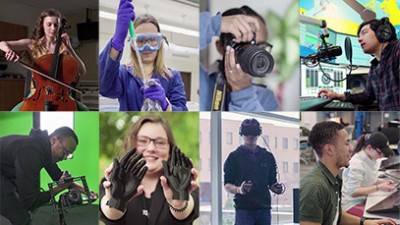RIT research examines spread and flow of soil contaminants
Assistant Professor Shima Parsa and Ph.D. student Michael Izaguirre have paper featured on the cover of ‘Soft Matter’
RIT
RIT researchers examined the spread and flow of emulsions in porous media in a paper recently published in the journal Soft Matter.
Understanding how contaminants in porous materials flow and are transported is key in the fields of industry, medicine, and environmental science. RIT Assistant Professor in the School of Physics and Astronomy Shima Parsa and Michael Izaguirre ’24 Ph.D. (imaging science) recently had their research on the topic published and featured on the cover of Soft Matter, a journal by the Royal Society of Chemistry.
The team’s paper, “Emergence of preferential flow paths and intermittent dynamics in emulsion transport in porous media,” was inspired by Parsa’s work in the oil industry and aimed to understand how stable droplets of oil can be mobilized in a medium like soil. The research is important in helping predict where emulsions will flow and how fast they may spread when facing an environmental hazard like an oil spill.
“The main question we want to understand is how much are these emulsions going to be dispersed,” said Parsa. “Can we predict the zone of dispersion and the spread after an event like rain over an oil spill?”
The researchers examined the breakup of larger droplets (since smaller droplets are more stable and don’t want to break up), and how the larger droplets start to deform as they are pushed through porous media. That then creates more dispersion of the smaller, more stable droplets. They observed that there was always a preferential path. The experimental results from this paper are essential for developing large-scale machine learning algorithms to predict dispersion of contamination in terrestrial environments, which are currently under development in Parsa’s lab.
“You want to know if your medium has multiple different preferential paths and each direction they will be in, and that gives you more prediction on the spread of the contaminants,” explained Parsa.
Parsa added that Izaguirre relentlessly analyzed the data and brought big ideas to research she had been working on for years. The research was funded in part by the American Chemical Society Petroleum Research Fund. The goal is that the oil industry and environmental agencies can now use this information when trying to clean up and control the spread of contamination.













